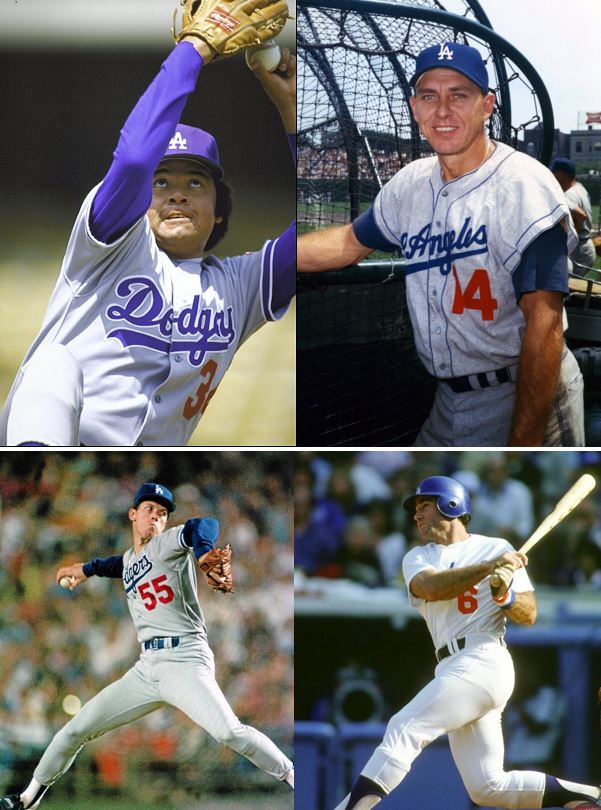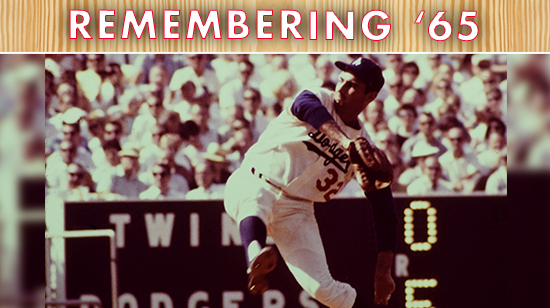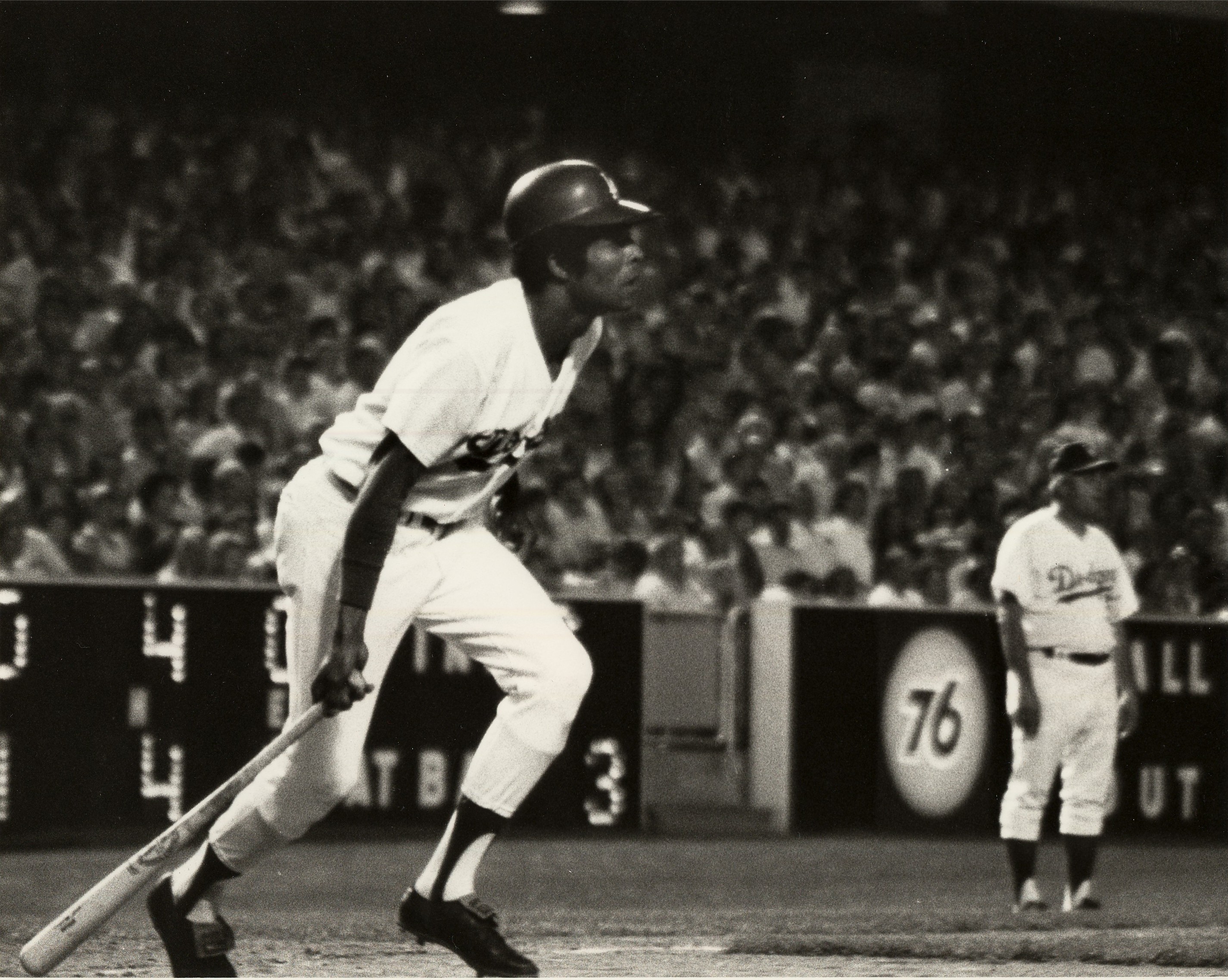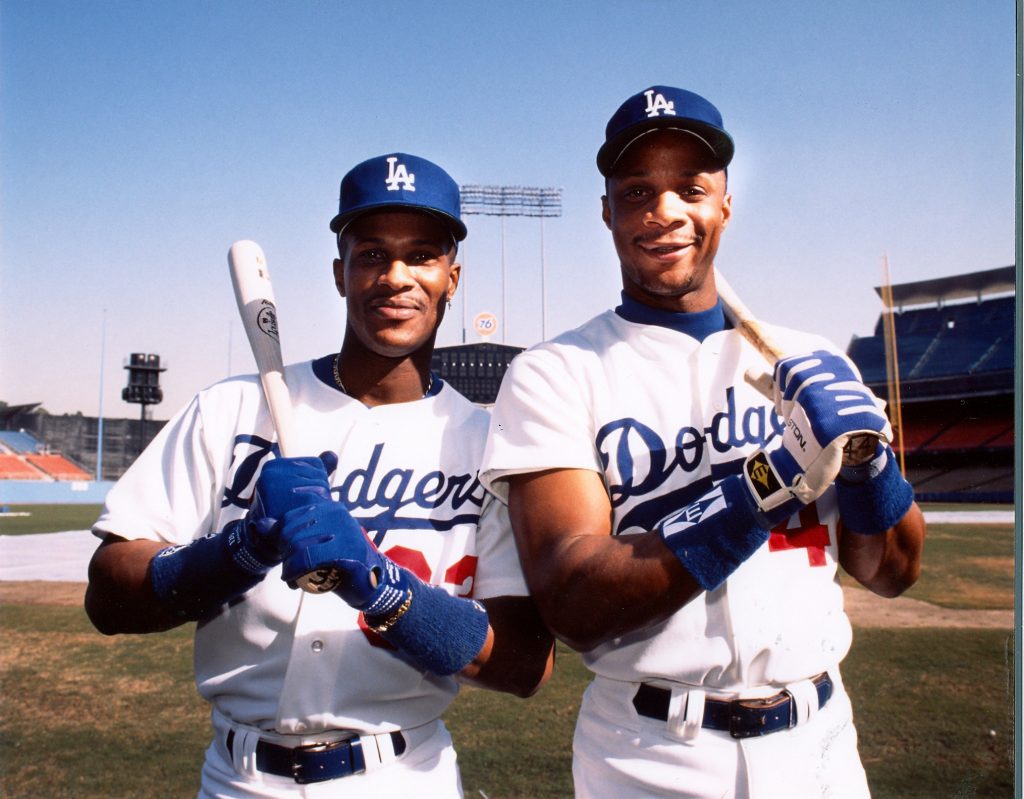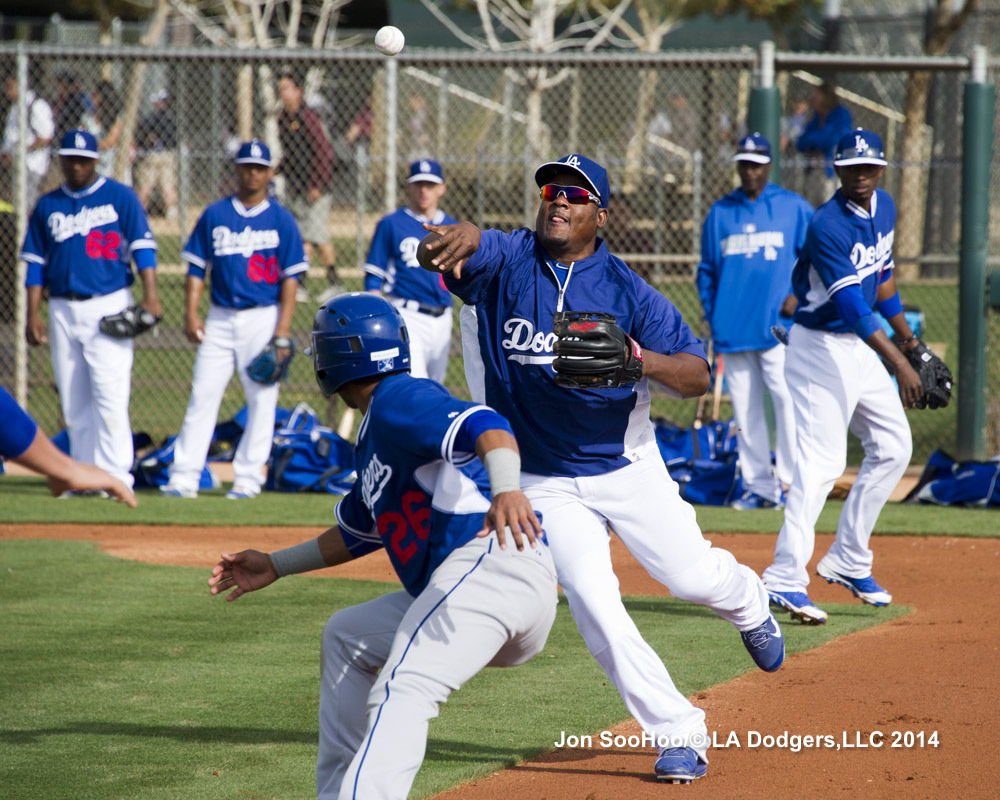So now Fernando Valenzuela has to get in. So now Gil Hodges has to get in. So now Orel Hershiser has to get in. So now Steve Garvey has to get in. So now …
Tag: Willie Davis
Today, we remember Alan Young, the “Mr. Ed” actor who passed away Thursday at age 96. Young and his horse companion made a memorable visit to Dodger Stadium for the 1963 season premiere, highlighted above. Sandy Koufax, Willie Davis, Leo Durocher, Johnny Roseboro and more appear.
By Jon Weisman
Pretty much the only drama in Game 5 of the 1965 World Series was whether Sandy Koufax would throw another perfect game or no-hitter.
By Jon Weisman
One day in May, this little item appeared deep in the game notes of the Times’ Frank Finch:
Maury Wills and Willie Davis cut records with Stubby Kaye Friday afternoon as well as doing single platters. During the session Jimmy Durante made a record called ‘Dandy Sandy,’ singing the praises of Prof. Koufax. Wills said it would be a smash.
You didn’t think I would leave you hanging, did you?
By Jon Weisman
Willie Davis, who had more hits than any player in Los Angeles Dodger history, died five years ago today, at the age of 69.
At Dodger Thoughts, you can read my chapter about Davis from 100 Things Dodgers Fans Should Know & Do Before They Die.
He was also a principal figure in one of my favorite pieces, this column I wrote for SI.com in 2007:
By Jon Weisman
Several former Dodgers will be inducted into the Los Angeles City Section Hall of Fame, honoring the best in athletics from Los Angeles Unified School District schools.
Willie Davis (Roosevelt ’58), Darryl Strawberry (Crenshaw ’78) and Eric Davis (Fremont ’80) have been selected, reports Eric Sondheimer of the Times, as has longtime Major League manager Gene Mauch (Fremont ’43), whose playing debut came with Brooklyn at age 18 in 1944.
The most long-ago inductee is former New York Yankees outfielder Bob Meusel, who graduated from Manual Arts exactly 100 years ago.
If you’re wondering why it took some of these names so long to make it, the City Section Hall of Fame is only in its third year of existence. Don Drysdale and Eddie Murray are among the previous inductees.
Speaking of Halls of Fame, Andre Ethier and his wife Maggie were both inducted Saturday into the Arizona State Sports Hall of Fame. Maggie Germaine Ethier had nine perfect 10.0 scores, the most in ASU gymnastics history, according to Jeff Metcalfe of AZCentral.com. The pair met at freshman orientation and began dating as juniors, Metcalfe wrote.
2014 Sun Devil Athletics Hall of Fame inductees with @SunDevilRay23 #MaroonMonsoon pic.twitter.com/mwWmpcRcn0
— Sun Devil Athletics (@TheSunDevils) October 19, 2014
By Jon Weisman
Take heed: With this year’s trip to Australia, the Dodgers’ process for determining the regular season active roster is even more unusual than you might imagine, according to Ken Gurnick of MLB.com.
First, there’s this rather stunning comparison.
“The Dodgers will have only 19 days of Spring Training games to make nearly all of their decisions,” Gurnick writes. “Last spring, they played 36 games before Opening Day.”
But further confusing matters is that the Dodgers’ don’t actually have to settle where everyone beyond the 25-man roster has to go before Sydney.
… Even though the 25-man roster officially doesn’t need to be submitted until March 21 at 1 p.m. PT, the Dodgers and D-backs will break camp on March 16 and take a maximum of 30 players to Australia from which to draw their 25-man Opening Day rosters.
Players on the disabled list can be back-dated to March 19, but those decisions might be made before the flight west, if not announced.
From the 30 players who can make the flight across the Pacific Ocean, three will be designated as “exempt” before Opening Day and would otherwise be active, be they starting pitchers left behind, players out of options (like Javy Guerra or Drew Butera) or Rule 5 selections (like Seth Rosin). Corresponding moves would need to be made to make room for their activation.
The other two players on the trip will be “extras” that can be players on the 40-man roster with options, or Minor Leaguers.
From these five additional players, clubs must be covered by position for an injury, whether it occurs as a result of the exhibition game against Team Australia, or the regular-season opener, because it will be impossible to call up a player and transport him to Australia in time for the next game. So, the five spots are likely to include at least one catcher, one middle infielder, one outfielder and one reliever. …
Read more about it here. Elsewhere around the Dodgers …
- Andre Ethier echoed Matt Kemp’s sentiments about no potential starting outfielder seeking out a spot on the bench. Mark Saxon of ESPN Los Angeles adds context.
… Ethier moved from right to center when Kemp got hurt last year, but before that he was entrenched in right field the previous four seasons. He said he’s willing to give the utility role a go if it helps the team.
“I’ve done a lot personally and done a lot with this team and I think we’re still just missing one thing, [a World Series], so if it’s something that leads to that, let’s figure out a way to get it done,” Ethier said. …
- Saxon quotes Don Mattingly on Yasiel Puig weighing in at about 25 pounds more than last year: “We don’t feel it’s going to be a problem, but we’re paying attention to it, put it that way,” Mattingly said.
- There’s no urgency for Paul Maholm to be ready to pitch regular-season games before April, and given that he’s behind the other starters, as Gurnick notes, he could use the extra time.
- Miguel Rojas’ wife flew out of strife-heavy Venezuela this morning, reports J.P. Hoornstra of the Daily News.
- Today’s guest star in Ernest Reyes’ series on the 1961 Union Oil Dodger Family Booklet series at Blue Heaven: Willie Davis.
[youtube=http://www.youtube.com/watch?v=moMjp74w54Q&w=550&h=413]
By Jon Weisman
In 1984, KTTV Channel 11 took this look at the history of the Dodgers-Giants rivalry. Among the incidents that don’t get as much attention these days are the 1971 brawl that had echoes of the famous Juan Marichal-Johnny Roseboro calamity, with Mays and Marichal once again pivotal figures, and a 1978 outfield collision at Candlestick Park that triggered a bizarre finish.
For what it’s worth, the next batter after that 1971 brawl, Willie Davis, hit a two-run home run.
Here’s a more recent picture of Elaine Perkins, who introduces the video above.
Amid all of Clayton Kershaw’s accomplishments this season, one feat has been seemingly out of reach – an ERA title.
As recently as a week ago, Kershaw trailed Cincinnati’s Johnny Cueto by about half a run, 2.51 to 2.05. Today, however, Kershaw takes the mound trailing Cueto by only 0.16, 2.45 to 2.29.
Since Independence Day, Kershaw has an ERA of 1.18 with 74 strikeouts in 76 innings and an opponents’ OPS of .533.
* * *
- The Dodgers, who have needed nine reliever innings in the past two days, added Ramon Troncoso to their roster for today’s game. More help will be on the way after the Albuquerque season ends Monday. Reinforcements from Chattanooga, if any, will take longer because the Lookouts are headed to the Southern League playoffs, running through at least September 10.
- In the New York Times on Friday, Richard Sandomir wrote about how much the Dodgers are being billed by their bankruptcy lawyers.
- Thanks to Ernest Reyes of Blue Heaven for the link to Vin Scully’s 1963 description of “What Is a Dodger?” Suitable for a bedtime story …
There’s more – all on the album “Jackie Barnett Presents The Sound of the Dodgers” – from noted stage and singing stars Stubby Kaye, Jimmy Durante, Maury Wills and Willie Davis. And to wrap things up, one more piece from Vin: “The Story of the Dodgers.” Note his pronunciation of “Chavez.”
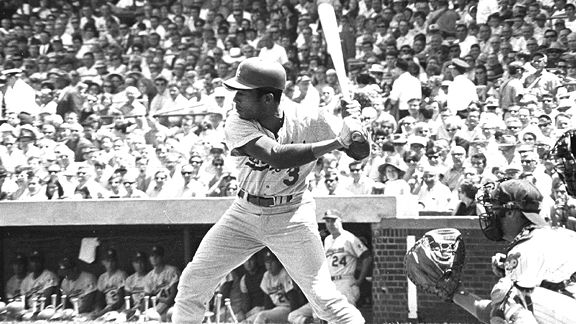
Rogers Photo Archive/Getty ImagesWith Walter Alston looking on from the dugout, Willie Davis stands in the batter’s box in 1969.
Four years ago, I wrote about the 31st game of Willie Davis’ record-setting Dodger hitting streak and Vin Scully’s broadcast of it:
… In the bottom of the seventh inning of the 1969 game, his hitting streak on the line, Davis tried to bunt his way aboard, to no avail. With the Dodgers still leading by four runs, and starting pitcher Claude Osteen having thrown 25 1/3 consecutive scoreless innings, it appeared Davis’ pursuit was done.
But in the top of the eighth, New York’s Tommie Agee and Donn Clendenon each hit two-run home runs, tying the game. The Dodgers were stunned — so stunned, they didn’t collect themselves before the next Mets batter.
“Ron Swoboda hits the ball to Osteen, who throws him out — and [Dodger manager] Walter Alston was on the field! He was heading to take Osteen out, when Swoboda hit the first pitch back to the box,” Scully exclaimed with amazement.
On top of that, the tie meant that opportunity had made a U-turn back toward Davis. And in the bottom of the eighth, two walks alternating with two strikeouts presented a unique conundrum for Dodger fans, one that Scully didn’t hesitate to point out.
“If the pitcher makes out, or whoever bats for him [it would be Willie Crawford], then Willie Davis will then be the No. 3 hitter in the ninth inning — unless the Dodgers get a run and win it, of course,” Scully said.
“And boy this is a really tough one, isn’t it? Crawford is trying to win the game. If he makes the last out in the eighth, Willie Davis will get another shot at extending his streak.”
Crawford grounded out, and then the Mets stranded a runner at second base in the top of the ninth, setting up Maury Wills, Manny Mota and Davis to bat in the bottom of the inning.
Delightfully for drama’s sake, Wills singled sharply to left field.
“And for more of the fun for the folks in the stands trying to figure out about Willie Davis,” Scully said, “if Mota sacrifices Wills to second, will they pitch to Willie? Left-handed pitcher on the mound. He’s a left-handed batter.”
“And now we are faced with that situation — do you walk Willie Davis?” Scully continued after Mota did bunt, successfully. “He’s getting an ovation. The one thing in his favor, oddly enough, is there’s a left-handed pitcher on the mound. If there’s a right-hand pitcher, the odds figure for sure they would walk him intentionally. But what will they do with a left-hander? I tell you what, if they walk him, you’re going to hear a few boos.
“Duffy Dyer is standing up behind the plate. And let’s see. If he does not go in a crouch, they’re going to put him on. Dyer looks over at [Mets manager Gil] Hodges. He’s not in a crouch … and now he goes in a crouch! They’ll pitch to him. Dyer kept looking at Hodges, and finally settles in a crouch. And Davis has one last swing — or is it the last swing?
“Bottom of the ninth, 4-4. [Jack] Dilauro looks at Wills. The left-hander at the belt. The pitch to Willie. … Soft curve — it’s a base hit to left! Here comes Wills; he will score!”
As he knows to do so well, Scully stayed silent to let his listeners hear the crowd cheer — for 44 seconds. And when he came back, he had this:
“Day after day, and year after year, the Dodgers remain the Dodgers. And through all the lightning bolts, the thunder, the heartbreaks, the laughs and the thrills, it’s comforting to know in this wacky world, the Dodgers are still the Dodgers. Incredibly enough, Willie Davis, on one last shot, when the question was in doubt if he would be even allowed to swing the bat, gets a ninth-inning game-winning base hit to extend his hitting streak to 31. And as Alice said, ‘Things get curiouser and curiouser.’ What a finish.” …
If Andre Ethier blows past the halfway point to Joe DiMaggio tonight and is going for 31 games in a row Friday, it will be against … the Mets — but in New York. Unfortunately, unless he decides to make an exception to his travel schedule, Scully wouldn’t be there to broadcast it.
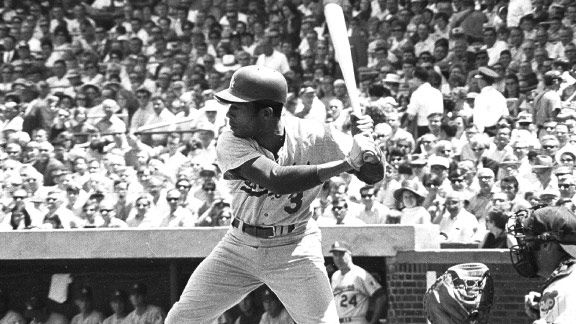
Rogers Photo Archive/Getty Images
Willie Davis in Chicago in 1969, the year of his 31-game hitting streak. Walter Alston can be seen in the background.
Ben Platt of MLB.com covered today’s memorial for Willie Davis at Dodger Stadium. The Associated Press also has a report.
* * *
Tony Jackson of ESPNLosAngeles.com has a wonderful feature on Jamie Jarrin.
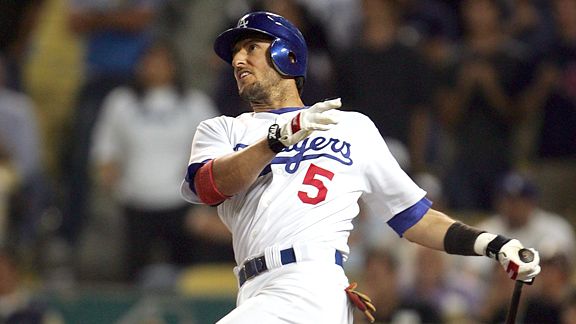
Jeff Gross/Getty Images
Nomar Garciaparra follows through in the 10th inning, Sept. 18, 2006.
Nomar Garciaparra, whose place in Dodger lore was cemented with his game-winning home run in the 4+1 game, announced his retirement today. He is moving on to work for ESPN as a “Baseball Tonight” and game analyst.
| Rafael Furcal, SS Blake DeWitt, 2B Andre Ethier, RF Matt Kemp, CF Brian Giles, DH Reed Johnson, LF Doug Mientkiewicz, 1B Nick Green, 3B A.J. Ellis, C (Vicente Padilla, P) |
Continuing the theme of the day, Garciaparra had nine walkoff hits in his career and five in his three Dodger seasons — four of them in 2006. Garciaparra had another game-winning home run six days after the 4+1 game.
Rob Neyer of ESPN.com is among those with more on Garciaparra.
* * *
- Memories of Willie Davis have dotted the Internet. Here are a selected few, provided by Tony Jackson of ESPNLosAngeles.com, Phil Gurnee of True Blue L.A., Buster Olney of ESPN.com, Neil Paine of Stat of the Day and Bruce Jenkins of the San Francisco Chronicle. Also, Steve Dilbeck of Dodgers Blog interviewed former Dodger owner Peter O’Malley about Davis. In addition, here’s a link to one of my favorite pieces, the 2007 SI.com column I wrote about Vin Scully in which Davis’ 31-game hitting streak played a prominent role.
- The Dodgers’ Taiwan sojourn left behind very few infielders in Arizona, Eric Stephen of True Blue L.A. notes.
- Ivan DeJesus, Jr. is the subject of the latest prospect profile at Memories of Kevin Malone.
- Vin Scully Is My Homeboy documents his trip to Camelback Ranch. Love the picture with George Foster.
- Forty years ago today, Ross Newhan of the Times celebrated the potential of the Dodgers’ young infield of “Billy Buckner, 20, Bill Grabarkewitz, 24, Bobby Valentine, 21 and Bill Russell, 21.” (via the Daily Mirror)
- Don Mattingly had this to say to reporters about his Dodger future:
“Everything will come off of what Joe does. I talked to the Dodgers after my first interview with Cleveland. They expressed that they wanted me to be a part of their future. Yes, the word ‘manager’ was brought up.”I like it here. I like California. Nothing definitive was said or done. … I’m not worried about money or things like that right now. I’m worried about our ballclub and soaking up as much as I can. I know where I want to go, but I have to keep my priorities straight.”
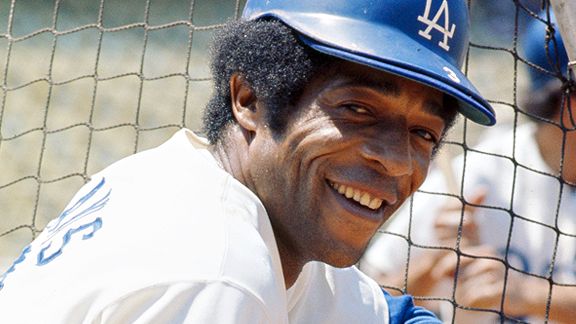
Herb Scharfman/Getty Images
Willie Davis in 1973, his final season with the Dodgers
The Los Angeles Dodgers’ all-time leader in hits, runs and total bases. Farewell, 3-Dog.
From 100 Things Dodgers Fans Should Know & Do Before They Die:
“I would say to myself, ‘This is the year,’ then every time I would go back to my old way of doing things.”
Inside and outside the Dodger organization, they never seemed to stop psychoanalyzing Willie Davis. No matter what he did — whether it was hitting 21 homers while stealing 32 bases in 1962, or moving up the franchise leaderboard (he remains first all-time in Los Angeles history in plate appearances, hits, total bases, triples and extra-base hits) — second-guessing was ongoing, acceptance grudging. The focus inevitably turned to Davis’ internal struggle as a ballplayer, his identity crisis.
“People have been saying for several years that if Willie Davis ever put all his talents together he would be an outstanding ballplayer. The trouble is nobody could ever convince Willie,” Dan Hafner of the Los Angeles Times wrote just before the 1968 season.
Around the time he first came up as a 20-year-old in 1960, some called Davis the second coming of Willie Mays. Those who saw him run insisted that he was faster than basestealing king Maury Wills. But the combination of Davis’ underwhelming offensive numbers following that ’62 season and his endless tinkering with his batting stance kept him under scrutiny for the entire decade.
“Willie, you see, did imitations,” wrote Jim Murray. “The only way you could tell it wasn’t Stan Musial was when he popped up. But Willie’s repertoire included Ted Williams, Billy Williams, Babe Ruth, Babe Herman (usually it came out more like Babe Phelps). He had more shticks than a Catskill comic. He wasn’t a ballplayer, he was a chameleon. Sometimes, he imitated three different guys in one night. None of them was Willie Davis. ‘Willie,’ Buzzie Bavasi used to ask him, ‘Why don’t you arrange it so that somebody imitates you?’”
Even when Davis rolled out a 31-game hitting streak in the late summer of 1969 – the longest streak in baseball since Stan Musial in 1950, baseball held its breath.
“First he tried to be Stan Musial and then Ernie Banks and he would imitate every hot hitter that came along,” Montreal manager Gene Mauch told Ross Newhan of the Times. “Now he’s simply Willie Davis and he’s damn exciting. If he goes 0-for-10 and changes, he’ll be a darn fool.”
Even his teammates, the guys he won two World Series titles with, were left unsatisfied.
“Willie Davis, throughout the 1960s, was regarded as a huge disappointment, a player who never played up to his perceived ability,” historian/statistician Bill James wrote. “As John Roseboro said, ‘He has never hit .330 in his career. But he should have.’”
But James goes on to make the point that however vexing Davis was, he was judged too harshly, with contemporaries not appreciating the difficult hitting conditions he played in. The mid-1960s in general, and Dodger Stadium in particular, depressed offense considerably.
“Davis was a terrific player,” James said. “True, he didn’t walk, and he was not particularly consistent – but his good years, in context, are quite impressive. … He should not be regarded as a failure, merely because he had to play his prime seasons in such difficult hitting conditions.”
After the 1973 season, Davis still had enough value to be traded to Montreal for reliever Mike Marshall, who would win the NL Cy Young Award for the Dodgers in ‘74. But Davis played for seven teams (including two in Japan) in his final six seasons, stability having left his baseball life forever.

